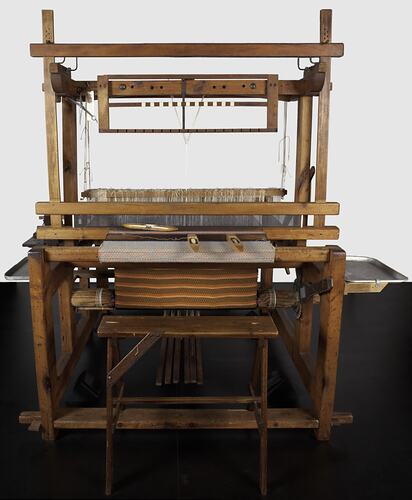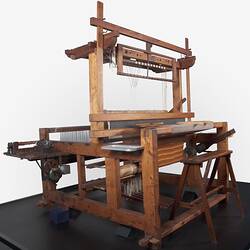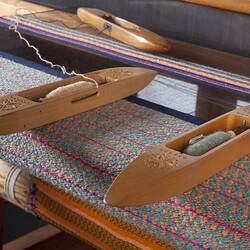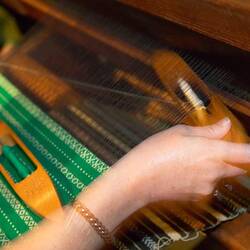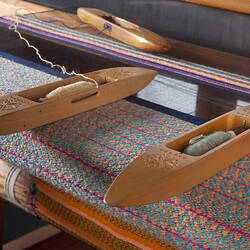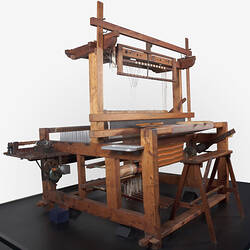Summary
Countermarch Floor Loom made for Anna Apinis by fellow survivors of World War II, in Memmingen, a displaced persons camp in Germany with wood scavenged from bombed-out ruins. It was designed by Anna's husband Ervins. Anna used the loom to weave traditional Latvian designs using threads gathered by unravelling old scraps of fabric. Anna brought the loom with her to Australia and continued to weave Latvian designs on it, both traditional and experimental. She also taught her daughter Anita to weave on this Loom and together they kept alive their Latvian culture.
Physical Description
Countermarch floor loom made of recycled timber. Loom is fitted together with wooden pegs and steel bolts; no nailing is used. The loom is made up of many pieces which enable it to be dismantled and reconstructed. Pieces include seat, treadles, warp and cloth beams. The shafts and lams are suspended from jacks in the centre of the frame. Cords attach the treadles to the lams, so that when the treadle is pressed, whichever shafts are to be lowered for that shed are pulled down and the remaining shafts are raised.
Significance
Looms are symbols of artistic skill, cultural maintenance and universal female traditions. This loom looks like so many other looms, but it has a special story.
Anna Apinis was born in 1913 in Latvia. She attended weaving lessons in Latvia from 1930 to 1933 and spent hours at the nearby Liepaja Ethnographic Museum (is this the Liepaja Museum - which includes ethnography?), recording traditional fabric designs in her notebooks. Anna continued compiling these notebooks throughout her years in a Displaced Persons camp after World War II. Anna had the loom constructed for her by fellow (male) survivors of the Second World War. The loom was made in Memmingen, a displaced persons camp in Germany with wood scavenged from bombed-out ruins; Anna's husband Ervins used his engineering skills to draw plans of the loom. Anna painstakingly sketched and documented ancient Latvian designs from the regional costumes rescued by other Latvian refugee women. She then wove them on her loom with threads gathered by unravelling old scraps of fabric.
Anna was able to bring her precious loom when she migrated to Australia with her father Ernest, husband Ervins and son Erik in 1950 on the navy troop carrier, SS General C. C. Ballou. This was a blessing as her obsession with weaving helped to ease the pain of displacement and separation that she and her husband Ervins felt in their new land. As suitable weaving materials were difficult to find in post-war Australia, Ervins designed an unplying machine in Parkes Holding Centre in Canberra in 1950 where they stayed upon arrival. Made from cans, scrap metal and wood, he used the machine to unply balls of wool to make weaving threads for Anna (this unplying machine remains in the MV collection). Ervins was actively involved in helping Anna with her craft and designed other weaving devices used by Anna. In Latvia, Ervins worked as a qualified road engineer. After arriving in Australia, he was employed as a railway labourer, eventually becoming a rail-bond welder. He remained in this work until his retirement.
Anna became one of the few suppliers of fabric for Latvian national costumes in Australia in the 1950s and 1960s, and exhibited her weaving nationally, at exhibitions and Latvian cultural festivals. She fulfilled her dream to keep her cultural traditions alive through her daughter Anita who continues to weave on Anna's loom to this day. Ervins and Anna had always encouraged Anita, to become involved in the Australian Latvian community; taught to weave at an early age, Anita shares her mother's passion for weaving. Anna passed away in 1997; Ervins in 1999.
A similar loom (now being deaccessioned) was acquired from the donor by the Museum in 1996. It had been displayed at the Immigration Museum from 1998 until March 2007. The two looms have very similar stories but, now that the original Anna Apinis loom has been offered to the Museum (which had remained in use by the donor until recently), the decision has been made to acquire this one, and deaccession the other.
The loom was identified as a treasure of the Museum Victoria collection during the 150th anniversary in 2004.
More Information
-
Collecting Areas
-
Acquisition Information
Donation from Mrs Anita Apinis-Herman, 01 Nov 2006
-
Place & Date Made
-
Designer
Mr Ervins Apinis, Memmingen, Germany, circa 1945
Of the Countermarch Floor Loom -
User
-
User
-
Classification
-
Category
-
Discipline
-
Type of item
-
Overall Dimensions
170 cm (Length), 143 cm (Width), 188 cm (Height)
-
Keywords
Handcrafts, Latvian Communities, Latvian Immigration, Looms, Weaving, Woodworking, Refugees, Displaced Persons, Displaced Persons Camps
